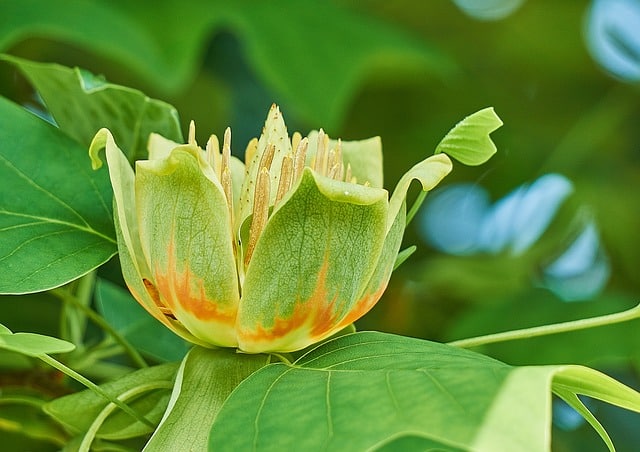Tulip Poplar tree dies mainly due to Verticillium wilt, a fungal disease. Root stress can also kill Tulip Poplar trees. The Tulip Poplar tree may also die due to transplant stress. The Tulip Poplar tree dies when it doesn’t get the amount of water it needs.
The Tulip poplar tree is called so because of its blossoms. The flowers resemble tulip flowers. The foliage looks wonderful.
This tree is not a poplar tree, it is somewhat related to the Magnolia tree. This tree makes for a wonderful garden tree.
It is easy to care for Tulip poplar. Sometimes people face problems growing it, they complain that their Tulip poplar is showing dying signs.
Why is my Tulip tree leaves turning yellow and dying?
Tulip tree leaves may turn yellow due to Root stress. This is chlorosis and happens when the roots can not absorb the necessary nutrients.
Root stress
Extended periods of hot, dry weather may deter the roots from absorbing water and nutrients. This combined with various other stress factors causes Root stress.
You’ll also observe black spots on the leaves when the roots are stressed. The spots appear in between the veins.
These symptoms are not harmful to the plant in the long term. But, it is a sign that you’re not caring well for the plant.
Such plants’ leaves turn yellow first, then turn brown and fall off. You can avoid this situation or fix this by watering the plant adequately.
Tulip tree dead branches
Branches of the Tulip tree wilt and die due to Verticillium wilt. It is a soil-borne fungal disease that attacks the roots way before the symptoms are visible.
If the roots of a side die then the respective part of the plant dies too. The older leaves shrivel first in Verticillium wilt. Drought-stressed plants are more vulnerable to the disease.
In most cases, the tree that’s affected can’t be saved. Destroy the stems of the tree by burning them away from the garden. Destroy the roots too.
Don’t plant any plant in the soil that’s prone to Verticillium wilt infection. Broad-leaved or Narrow-leaved evergreens can be grown in the same soil.
Why is my Tulip tree dripping sap?
The sticky sap you see on the Tulip tree is Honeydew. Honeydew is secreted by both Aphids and Spider Mites. The honeydew soon turns into Sooty Mold, a fungal growth. Sooty Mold forms black spots on the leaves.
This situation is seen in two types of infections.
Aphid infection
Aphids are small, pesky pests that infect thousands of tree species. Aphids excrete honeydew which drips down the tree.
Honeydew is harmful also because it invites Sooty mold infection. Sooty mold is a fungal infection and can harm the plant cosmetically.
Tulip tree aphids specifically affect Tulip trees and are golden-yellow in appearance. Check your leaves closely and confirm their presence before treating the plant.
To fix:
- To control aphids biologically you can introduce Ladybugs/Wasps onto the infected plant.
- You can spray Safers soap on infected leaves. I usually spray them in June. One can spray the plant till mid-July. If the infection is severe, two sprays may be needed.
- You can spray an insecticide too, one which works on aphids. Contact your local Arborist if you’re unsure which one to use.
Scale infection
Tulip poplars have very few pests. Scale is one of them. Scale is a sap-sucking insect that can be seen on the twigs.
These scale feed on tree’s limbs and branches, excreting sap called Honeydew. This honeydew as we already know, attracts Sooty mold.
A severe scale infection could kill the plant! So it is crucial to treat a scale-infested plant as soon as possible.
How to treat Tulip tree scale
- Biological control of scale infestation is hard because scale multiplies quickly and affect the whole plant before you know it.
- Spray registered insecticides on the infected plant from mid-August through mid-September. Repeated applications may be needed. Irrigate the soil well before applying the insecticide.
- If the tree is small, spray horticulture oil in the spring. Repeated applications will prevent an outbreak.
Your Tulip Poplar Tree Leaves Are Brown?
Tulip Poplar Tree leaves turn brown due to underwatering. Tulip Poplar leaves turn brown also due to transplant stress.
Underwatering
Until the plant is established, you need to water it abundantly. Water the plant in the morning and in the evening.
Do not let the soil go dry. The natural habitat of these plants is near rivers, so they demand a surplus supply of water.
Apply good organic mulch around the tree to lock in moisture during dry, hot weather. Check the soil with your finger and water when the soil is dry.
Transplant stress
Browning of the foliage may also happen when the plant is stressed due to a change of habitat/location. Make sure you acclimate the plant slowly to new conditions.
Transplant stress may last for many days. Just care well for the plant. Make sure the soil has good drainage. Water the plant well.
Why doesn’t my Tulip tree bloom?
Tulip trees focus mainly on the production of leaves, at least for the first 15 years. Then the Tulip trees will blossom every year.
If you’ve grown the tree yourself, you know how old it is. It is hard to know the age of a nursery-grown plant.
Sometimes, an aphid/scale infection may be the reason why a well-established plant fails to flower. Fix the issue accordingly and you may see blossoms yet.
Why is my Tulip tree losing leaves in summer?
Tulip Poplar leaves become yellow first and they fall off. This happens at the end of the growing season. This is triggered by even a brief loss in soil moisture.
This is completely normal in my opinion. Many tulip trees experience the same in the summer. This is the plant’s response to the hiking temperatures.

